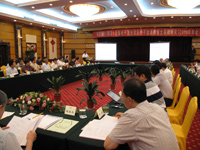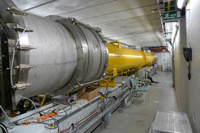 |
 |
|||||||||||||
|
|||||||||||||
|
|||||||||||||
The European X-ray Free Electron Laser (European XFEL) and the Facility for Antiproton and Ion Research (FAIR) are two important international cooperative science facilities mainly led by Germany. China has participated in the R&D of some detectors, low-temperature systems, high-performance undulators, superconducting material and special material for these projects. On 29 August 2008, the project "Basic Research on the FEL and FAIR" supported by China's national programme for key basic research and development (officially called 973 programme) started. The project is coordinated by the Institute of High Energy Physics, Chinese Academy of Science (IHEP), and about ten different research institutes, universities and corporations in China participate in this project, including the Institute of Modern Physics, Peking University, Tsinghua University, Orient Tantalum Industry Corp. (OTIC), etc. The annual meeting of this project was held on 6 August 2010, jointly organised by IHEP and OTIC. Members of the project expert group and officials from the Ministry of Science and Technology (MOST) of the People's Republic of China and the Chinese Academy of Sciences attended. “The main purpose of the project is to track the international frontier of the development trend in physics, to carry out related research on key technologies, to train research teams, and to raise the level of related basic research,” said Yiqi Peng, officer of MOST. Prof. Xiaoming Jiang, chief scientist of the project and deputy director of IHEP, gave a general introduction on the current progress of the project. Seven sub-research teams reported on the respective progress with quite important milestone achievements in the past two years. In the research related on the European XFEL facility, the manufacture of the newly-developed undulator prototype designed by DESY in Germany has been finished with efficient help from DESY experts. It is now undergoing magnetic measurement in a domestic laboratory, and will be transported to DESY in Germany for tests at the end of this year. The prototype of the European XFEL cryomodule passed the final test at DESY in 2009, and has already been installed in the FLASH facility as an operating cryomodule. In terms of the research on superconducting cavities, large-grain high-purity and high-performance niobium was successfully used for superconducting cavities, and the company OTIC that provided the niobium material has been authorised in the European XFEL's suppliers list. Prof. Hesheng Chen, the director of IHEP, spoke highly of OTIC: “Their corporation made great contributions to the research of large-grain niobium, which is a successful example for collaboration between large science projects and high-tech industries.” The project of basic research on the XFEL and FAIR will be finished in 2013, and the subsequent arrangements and work plans were discussed during the annual meeting. The technologies researched and developed by the project, such as the cryomodule and the superconducting cavity, will be a great help for the R&D of ILC-related accelerator technology in the near future. -- Min Zhang |
|||||||||||||
| © International Linear Collider |

